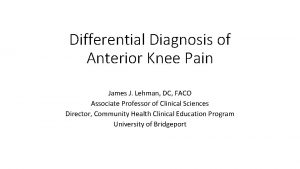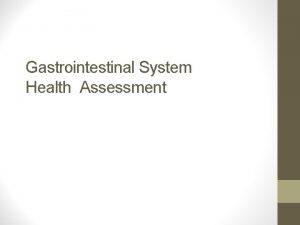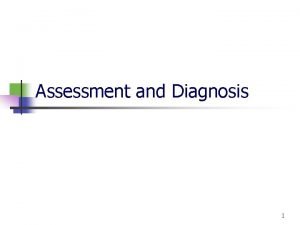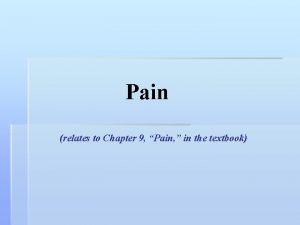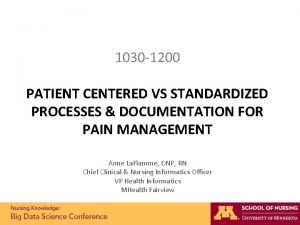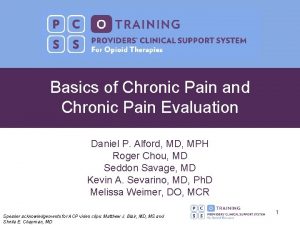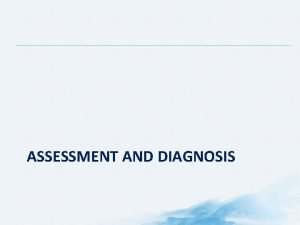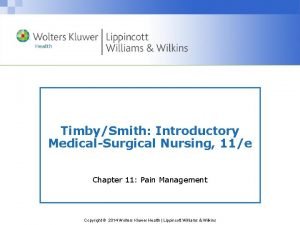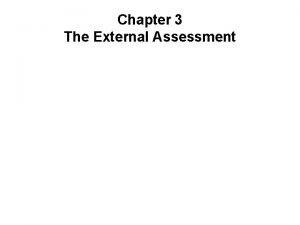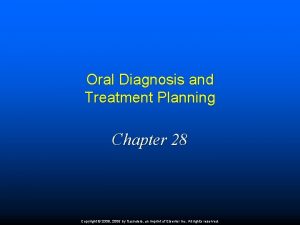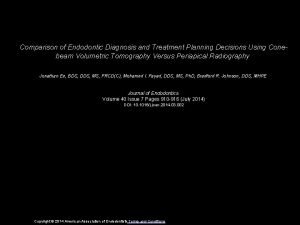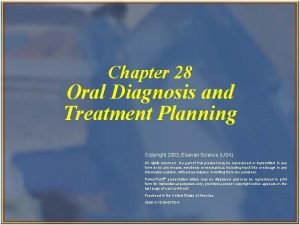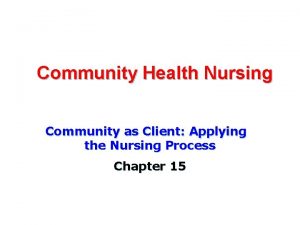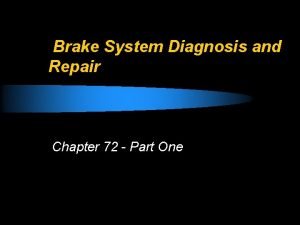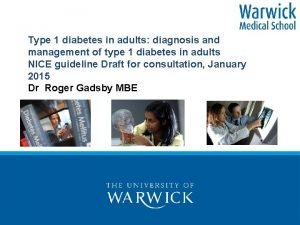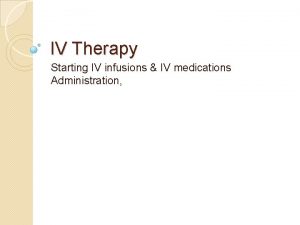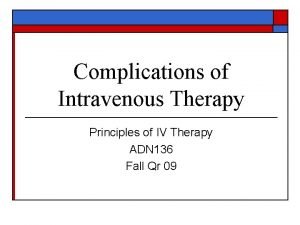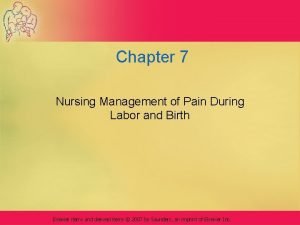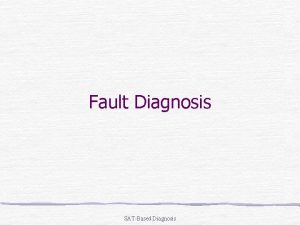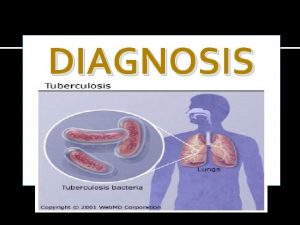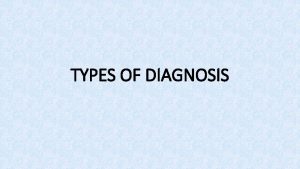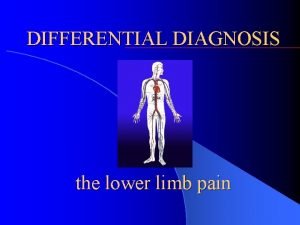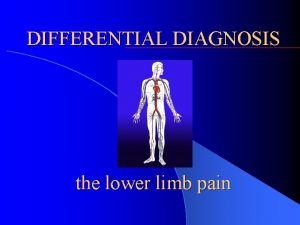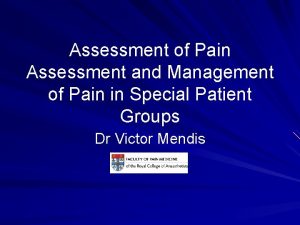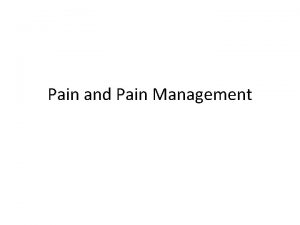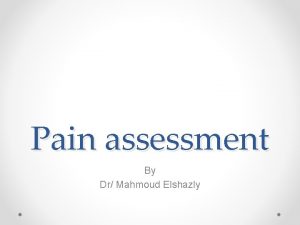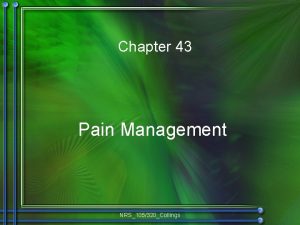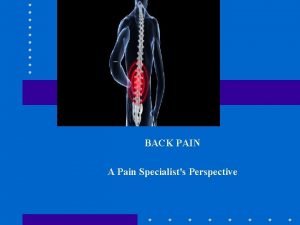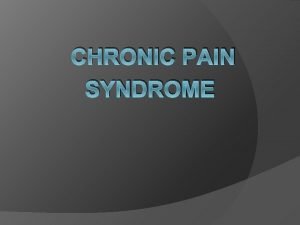ASSESSMENT AND DIAGNOSIS Importance of Pain Assessment Pain











































- Slides: 43

ASSESSMENT AND DIAGNOSIS

Importance of Pain Assessment Pain is a significant predictor of morbidity and mortality. • Screen for red flags requiring immediate investigation and/or referral • Identify underlying cause – Pain is better managed if the underlying causes are determined and addressed • Recognize type of pain to help guide selection of appropriate therapies for treatment of pain • Determine baseline pain intensity to future enable assessment of efficacy of treatment Forde G, Stanos S. J Fam Pract 2007; 56(8 Suppl Hot Topics): S 21 -30; Sokka T, Pincus T. Poster presentation at ACR 2005.

Comprehensive Pain Assessment Assess effects of pain on patient’s function Characterize pain location, distribution, duration, frequency, quality, precipitants Complete risk assessment Take detailed history (e. g. , comorbidities, prior treatment) Clarify etiology, pathophysiology Conduct physical examination National Pharmaceutical Council, Joint Commission on Accreditation of Healthcare Organizations. Pain: Current Understanding of Assessment, Management, and Treatments. Reston, VA: 2001; Passik SD, Kirsh KL CNS Drug 2004; 18(1): 13 -25.

Pain Assessment: PQRST Mnemonic • • • Provocative and Palliative factors Quality Region and Radiation Severity Timing, Treatment Budassi Sheehy S, Miller Barber J (eds). Emergency Nursing: Principles and Practice. 3 rd ed. Mosby; St. Louis, MO: 1992.

Locate the Pain Body maps are useful for the precise location of pain symptoms and sensory signs. * *In cases of referred pain, the location of the pain and of the injury or nerve lesion/dysfunction may not be correlated Gilron I et al. CMAJ 2006; 175(3): 265 -75; Walk D et al. Clin J Pain 2009; 25(7): 632 -40.

Pain History Components • • Location of pain Onset Provocative or palliative factors Quality Radiation and related symptoms Severity (intensity, effect on function) Temporal pattern (continuous vs. intermittent) Cognitive functioning and gender differences may affect a person’s self-report of pain; therefore, caregivers are commonly used as proxies for obtaining pain reports Parala-Metz A, Davis M. Cancer pain. Available at: http: //www. clevelandclinicmeded. com/medicalpubs/diseasemanagement/hematology-oncology/cancerpain/. Accessed March 19, 2015; Allen RS et al. Gerontologist. 2002; 42: 507 -14.

Physical Examination • Assess tumor response • Narrow differential diagnoses • Lead to appropriate diagnostic testing and empiric treatment in the presence of new complaints Patients with cancer indicate the physical exam is a highly positive aspect of their care Kadakia KC et al. Cancer. 2014; 120(14): 2215 -21.

Physical Examination • Most patients perceive the physical exam as strongly positive • Most feel that being examined provides a symbolic and pragmatic meaning • Exam has meaning beyond that of an investigative bedside tool – Symbolic: provides reassurance, caring, and hope – Pragmatic: results might directly affect diagnostic, prognostic, or therapeutic assessments • Increasing age is an independent predictor of a more positive perception of the physical exam • May provide an avenue to discuss issues and avoid unnecessary tests Kadakia KC et al. Cancer. 2014; 120(14): 2215 -21.

Tools for the assessment of cancer pain

Assessing Acute Pain Intensity Visual analog scale (VAS) Self-rating on a 0– 100 mm scale £ Numerical rating scale Self-rating on a 11 -point scale: 0 = no pain to 10 = worst pain Time-specific pain intensity “My pain at this time is: none, mild, moderate, severe” (0 to 3 rating) Impact of Pain on Function American Pain Society (APS) questionnaire The degree to which pain interferes with patient function, such as mood, walking and sleep £ Brief Pain Inventory (BPI) Evaluates severity, impact and impairment on daily living, mood and enjoyment of life Time-specific pain relief “My pain relief at this time is: none, a little, some, a lot, complete” (0 to 4 rating) Coll AM et al. J Adv Nursing 2004; 46(2): 124 -133; Dihle A et al. J Pain 2006; 7(4): 272 -80; Keller S et al. Clin J Pain 2004; 20(5): 309 -18.

Brief Pain Inventory Cleeland CS, Ryan KM. Ann Acad Med Singapore 1994; 23(2): 129 -38.

Determine Pain Intensity Simple Descriptive Pain Intensity Scale Mild pain No pain Moderate pain Severe pain Worst pain Very severe pain 0– 10 Numeric Pain Intensity Scale 0 No pain 1 2 3 4 5 Moderate pain 6 7 Faces Pain Scale – Revised International Association for the Study of Pain. Faces Pain Scale – Revised. Available at: http: //www. iasppain. org/Content/Navigation. Menu/General. Resource. Links/Faces. Pain. Scale. Revised/default. htm. Accessed: July 15, 2013; Iverson RE et al. Plast Reconstr Surg 2006; 118(4): 1060 -9. 8 9 10 Worst possible pain

APS Questionnaire • Measures 6 aspects of pain quality: – Pain severity and relief – Impact of pain on activity, sleep and negative emotions – Side effects of treatment – Helpfulness of information about pain treatment – Ability to participate in pain treatment decisions – Use of non-pharmacological strategies Gordon DB et al. J Pain 2010; 11(11): 1172 -86.

APS Questionnaire Gordon DB et al. J Pain 2010; 11(11): 1172 -86.

Tools to Assess Psychiatric/Psychosocial Comorbidities

Depression Scales

PHQ-9 Kroenke K et al. J Gen Intern Med. 2001; 16(9): 606 -13.

Hospital Anxiety and Depression Scale A = anxiety; D = depression Zigmond AS, Snaith RP. Acta Psychiatr Scand. 1983; 67: 361 -70.

Hamilton Depression Rating Scale (HAM-D)

Montgomery-Åsberg Depression Rating Scale Montgomery SA, Asberg M. Br J Psychiatry. 1979; 134: 382 -9.

Beck Depression Inventory Beck AT et al. Arch Gen Psychiatry. 1961; 4: 561 -71.

Anxiety Scales

Beck Anxiety Inventory Beck AT et al. J Consult Clin Psychol. 1988; 56(6): 893 -7.

Hamilton Anxiety Rating Scale (HAM-A) Hamilton M. Br J Med Psychol. 1959; 32: 50 -5.

Hospital Anxiety and Depression Scale - Anxiety Question Frequency Score I feel tense or “wound up” Most of the time A lot of the time Occasionally Not at all 3 2 1 0 I get a sort of frightened feeling as if something awful is about to happen Very definitely and quite badly Yes, but not too badly A little, but it doesn’t worry me Not at all 3 2 1 0 Worrying thoughts go through my mind A great deal of the time A lot of the time From time to time, but not often Only occasionally 3 2 1 0 I can sit at ease and feel relaxed Definitely Usually Not often Not at all 0 1 2 3 I get a sort of frightened feeling like “butterflies” in the stomach Not at all Occasionally Quite often Very often 0 1 2 3 I feel restless as I have to be on the move Very much indeed Quite a lot Not very much Not at all 3 2 1 0 I get sudden feelings of panic Very often indeed Quite often Not very often Not often at all 3 2 1 0 Zigmond AS, Snaith RP. Acta Psychiatr Scand. 1983; 67: 361 -70.

Quality of Life Scale for Cancer Patients

HRQo. L Tools Used in Oncology General • Short Form 36 (SF-36) • Hospital and Anxiety Depression Scale (HADS) Cancer Specific • EORTC QLQ-30 • Functional Assessment of Cancer Therapy – General (FACT-G) • Rotterdam Symptom Checklist (RSCL) Bottomley A. Oncologist. 2002; 7(2): 120 -5.

Short Form 36 (SF-36®) SF-36® scales measure physical and mental components of health Ware, JE Jr. Available at: http: //www. sf-36. org/tools/SF 36. shtml.

Hospital Anxiety and Depression Scale A = anxiety; D = depression Zigmond AS, Snaith RP. Acta Psychiatr Scand. 1983; 67: 361 -70.

EORTC QLQ-C 30 • Questionnaire to assess quality of life of patients with cancer • For use in clinical trials (copyrighted) • 30 questions rated on a 4 -point Likert scale • Nine multi-item scales – Functional: physical, role, cognitive, emotional, social – Symptom: fatigue, pain, nausea and vomiting – Global health and quality of life • Several single-item symptom measures also included EORTC = European Organization for the Research and Treatment of Cancer Aaronson NK et al. J Natl Cancer Inst. 19933; 85(5): 365 -76.

Functional Assessment of Cancer Therapy – General (FACT-G) • 33 -item scale for patients receiving cancer therapy • Easy to administer • Brief • Reliable • Valid • Responsive to clinical change Cella DF et al. J Clin Oncol. 1993; 11: 570 -9.

Rotterdam Symptom Checklist (RSCL) • Self-report measure • 4 main scales: • Physical symptom distress • Psychological distress • Activity level • Overall global life quality • 4 -point Likert-type scales De Haes JCJM et al. The Rotterdam Symptom Checklist. Available at: https: //www. umcg. nl/Site. Collection. Documents/research/institutes/SHARE/assessment%20 tools/handleiding_rscl 2 edruk. pdf. Accessed March 20, 2015.

Tools to Assess Neuropathic Pain

Sensitivity and Specificity of Neuropathic Pain Screening Tools Name Description Sensitivity* Specificity* Interview-based NPQ 10 sensory-related items + 2 affect items 66% 74% ID-Pain 5 sensory items + 1 pain location NR NR pain. DETECT 7 sensory items + 2 spatial characteristics items 85% 80% Interview + physical tests LANSS 5 symptom items + 2 clinical exam items 82– 91% 80– 94% DN 4 7 symptom items + 3 clinical exam items 83% 90% Tests incorporating both interview questions and physical tests have higher sensitivity and specificity than tools that rely on interview questions *Compared with clinical diagnosis DN 4 = Douleur neuropathic en 4 questions; LANSS = Leeds Assessment of Neuropathic Symptoms and Signs; NPQ = Neuropathic Pain Questionnaire; NR = not reported Bennett MI et al. Pain 2007; 127(3): 199 -203.

LANSS Scale • Completed by physician in office • Differentiates neuropathic from nociceptive pain • 5 pain questions and 2 skin sensitivity tests • Identifies contribution of neuropathic mechanisms to pain • Validated LANSS = Leeds Assessment of Neuropathic Symptoms and Signs Bennett M. Pain 2001; 92(1 -2): 147 -57.

DN 4 • Completed by physician in office • Differentiates neuropathic from nociceptive pain • 2 pain questions (7 items) • 2 skin sensitivity tests (3 items) • Score 4 is an indicator for neuropathic pain • Validated DN 4 = Douleur neuropathique en 4 questions Bouhassira D et al. Pain 2005; 114(1 -2): 29 -36.

pain. DETECT • Patient-based, easy-to-use screening questionnaire • Developed to distinguish between neuropathic pain and non-neuropathic pain* • Validated: high sensitivity, specificity and positive predictive accuracy • Seven questions about quality and three about severity of pain • Questions about location, radiation and time course *Validation was in patients with low back pain Freynhagen R et al. Curr Med Res Opin 2006; 22(10): 1911 -20.

ID Pain • Patient-completed screening tool • Includes 6 yes/no questions and pain-location diagram • Developed to differentiate between nociceptive and neuropathic pain • Validated Portenoy R. Curr Med Res Opin 2006; 22(8): 1555 -65

Imaging in the Diagnosis and Management of Cancer Pain • • • Imaging of bone metastasis Spinal tumor imaging Plexus tumor imaging Celiac plexus imaging Tumor ablation Image-guided pain therapy – Image guidance to place a biopsy needle, therapeutic catheter, or ablation needle in the target • Vertebral tumor image-guided interventions – Vertebroplasty, percutaneous nerve blocks Cuevas C, Shibata D. Curr Pain Headache Rep. 2009; 13: 261 -70.

Literature Cited Aaronson, N. K. , Ahmedzai, S. , Bergman, B. , Bullinger, M. , Cull, A. , Duez, N. J. , … de Haes, J. C. (1993). The European Organization for Research and Treatment of Cancer QLQ-C 30: a quality-oflife instrument for use in international clinical trials in oncology. Journal of the National Cancer Institute, 85(5), 365– 376. Allen, R. S. , Haley, W. E. , Small, B. J. , & Mc. Millan, S. C. (2002). Pain reports by older hospice cancer patients and family caregivers: the role of cognitive functioning. The Gerontologist, 42(4), 507– 514. Beck, A. T. , Epstein, N. , Brown, G. , & Steer, R. A. (1988). An inventory for measuring clinical anxiety: psychometric properties. Journal of Consulting and Clinical Psychology, 56(6), 893– 897. Beck, A. T. , Ward, C. H. , Mendelson, M. , Mock, J. , & Erbaugh, J. (1961). An inventory for measuring depression. Archives of General Psychiatry , 4, 561– 571. Bottomley, A. (2002). The cancer patient and quality of life. The Oncologist, 7(2), 120– 125. Budassi Sheely, S. , & Miller Barber, J. (1992). Emergency Nursing: Principles and Practice. (3 rd Ed. ). St Louis: Mosby. Cancer Pain. (n. d. ). Retrieved June 19, 2015, from http: //www. clevelandclinicmeded. com/medicalpubs/diseasemanagement/hematologyoncology/cancer-pain/Default. htm

Literature Cited (Continued) Cella, D. F. , Tulsky, D. S. , Gray, G. , Sarafian, B. , Linn, E. , Bonomi, A. , … Brannon, J. (1993). The Functional Assessment of Cancer Therapy scale: development and validation of the general measure. Journal of Clinical Oncology: Official Journal of the American Society of Clinical Oncology, 11(3), 570– 579. Cleeland, C. S. , & Ryan, K. M. (1994). Pain assessment: global use of the Brief Pain Inventory. Annals of the Academy of Medicine, Singapore , 23(2), 129– 138. Coll, A. M. , Ameen, J. R. M. , & Mead, D. (2004). Postoperative pain assessment tools in day surgery: literature review. Journal of Advanced Nursing, 46(2), 124– 133. http: //doi. org/10. 1111/j. 1365 -2648. 2003. 02972. x Dihle, A. , Helseth, S. , Kongsgaard, U. E. , Paul, S. M. , & Miaskowski, C. (2006). Using the American Pain Society’s patient outcome questionnaire to evaluate the quality of postoperative pain management in a sample of Norwegian patients. The Journal of Pain: Official Journal of the American Pain Society, 7(4), 272– 280. http: //doi. org/10. 1016/j. jpain. 2005. 11. 005 Forde, G. , & Stanos, S. (2007). Practical management strategies for the chronic pain patient. The Journal of Family Practice, 56(8 Suppl Hot Topics), S 21– 30. Gilron, I. , Watson, C. P. N. , Cahill, C. M. , & Moulin, D. E. (2006). Neuropathic pain: a practical guide for the clinician. CMAJ: Canadian Medical Association Journal = Journal de l’Association Medicale Canadienne, 175(3), 265– 275. http: //doi. org/10. 1503/cmaj. 060146

Literature Cited (Continued 1) Gordon, D. B. , Polomano, R. C. , Pellino, T. A. , Turk, D. C. , Mc. Cracken, L. M. , Sherwood, G. , … Farrar, J. T. (2010). Revised American Pain Society Patient Outcome Questionnaire (APS-POQ-R) for quality improvement of pain management in hospitalized adults: preliminary psychometric evaluation. The Journal of Pain: Official Journal of the American Pain Society , 11(11), 1172– 1186. http: //doi. org/10. 1016/j. jpain. 2010. 02. 012 Hamilton, M. (1959). The assessment of anxiety states by rating. The British Journal of Medical Psychology, 32(1), 50– 55. Iverson, R. E. , Lynch, D. J. , & ASPS Committee on Patient Safety. (2006). Practice advisory on pain management and prevention of postoperative nausea and vomiting. Plastic and Reconstructive Surgery, 118(4), 1060– 1069. http: //doi. org/10. 1097/01. prs. 0000232390. 14109. f 5 Kadakia, K. C. , Hui, D. , Chisholm, G. B. , Frisbee-Hume, S. E. , Williams, J. L. , & Bruera, E. (2014). Cancer patients’ perceptions regarding the value of the physical examination: a survey study. Cancer, 120(14), 2215– 2221. http: //doi. org/10. 1002/cncr. 28680 Keller, S. , Bann, C. M. , Dodd, S. L. , Schein, J. , Mendoza, T. R. , & Cleeland, C. S. (2004). Validity of the brief pain inventory for use in documenting the outcomes of patients with noncancer pain. The Clinical Journal of Pain, 20(5), 309– 318. Kreme, K. , Spitzer, R. L. , & Williams, J. B. (2001). The PHQ-9: validity of a brief depression severity measure. Journal of General Internal Medicine , 16(9), 606– 613.

Literature Cited (Continued 2) Montgomery, S. A. , & Asberg, M. (1979). A new depression scale designed to be sensitive to change. The British Journal of Psychiatry: The Journal of Mental Science , 134, 382– 389. National Pharmaceutical Council, Joint Commission on Accreditation of Healthcare Organizations. (2001). Pain: Current Understanding of Assessment, Management, and Treatments. Reston, VA. Passik, S. D. , & Kirsh, K. L. (2004). Opioid therapy in patients with a history of substance abuse. CNS Drugs, 18(1), 13– 25. The Rotterdam Symptom Checklist. (n. d. ). Retrieved June 19, 2015, from https: //www. umcg. nl/Site. Collection. Documents/research/institutes/SHARE/assessment%20 tools /handleiding_rscl 2 edruk. pdf Walk, D. , Sehgal, N. , Moeller-Bertram, T. , Edwards, R. R. , Wasan, A. , Wallace, M. , … Backonja, M. M. (2009). Quantitative sensory testing and mapping: a review of nonautomated quantitative methods for examination of the patient with neuropathic pain. The Clinical Journal of Pain, 25(7), 632– 640. http: //doi. org/10. 1097/AJP. 0 b 013 e 3181 a 68 c 64 Zigmond, A. S. , & Snaith, R. P. (1983). The hospital anxiety and depression scale. Acta Psychiatrica Scandinavica, 67(6), 361– 370. , 0
 Collaborative nursing interventions
Collaborative nursing interventions Medical diagnosis and nursing diagnosis difference
Medical diagnosis and nursing diagnosis difference Second phase of nursing process
Second phase of nursing process Objectives of nursing process
Objectives of nursing process Perbedaan diagnosis gizi dan diagnosis medis
Perbedaan diagnosis gizi dan diagnosis medis Mad pain
Mad pain How do you know if your period is coming or your pregnant
How do you know if your period is coming or your pregnant Epigastric pain differential diagnosis
Epigastric pain differential diagnosis Osgood schlatter vs patellar tendonitis
Osgood schlatter vs patellar tendonitis Organs in body quadrants
Organs in body quadrants Period cramps vs early pregnancy cramps
Period cramps vs early pregnancy cramps Assessment for diagnosis
Assessment for diagnosis Pqrst pain assessment
Pqrst pain assessment Old carts example
Old carts example Pqrstu pain
Pqrstu pain Capa pain assessment tool
Capa pain assessment tool Wilda pain assessment
Wilda pain assessment Nips pain scale
Nips pain scale Comprehensive pain assessment
Comprehensive pain assessment Comprehensive pain assessment
Comprehensive pain assessment Pqrst pain scale
Pqrst pain scale Oldcart
Oldcart Jarvis chapter 11 pain assessment
Jarvis chapter 11 pain assessment External assessment in strategic management example
External assessment in strategic management example Charting identification chapter 28
Charting identification chapter 28 House classification in prosthodontics
House classification in prosthodontics Endodontic diagnosis and treatment planning
Endodontic diagnosis and treatment planning Power brake system
Power brake system Chapter 76 suspension system diagnosis and repair answers
Chapter 76 suspension system diagnosis and repair answers Chapter 42 gasoline injection diagnosis and repair
Chapter 42 gasoline injection diagnosis and repair Oral diagnosis and treatment planning ppt
Oral diagnosis and treatment planning ppt Automotive technology principles diagnosis and service
Automotive technology principles diagnosis and service Community as client
Community as client Brake pedal reserve distance
Brake pedal reserve distance Type 1 diabetes in adults diagnosis and management
Type 1 diabetes in adults diagnosis and management Hernia nursing care plan
Hernia nursing care plan Farm planning and budgeting
Farm planning and budgeting Characteristics of portfolio assessment
Characteristics of portfolio assessment Define dynamic assessment
Define dynamic assessment Portfolio assessment matches assessment to teaching
Portfolio assessment matches assessment to teaching Modified bassini repair
Modified bassini repair Iv site complications
Iv site complications Phlebitis vs infiltration symptoms
Phlebitis vs infiltration symptoms Chapter 7 nursing management of pain during labor and birth
Chapter 7 nursing management of pain during labor and birth








